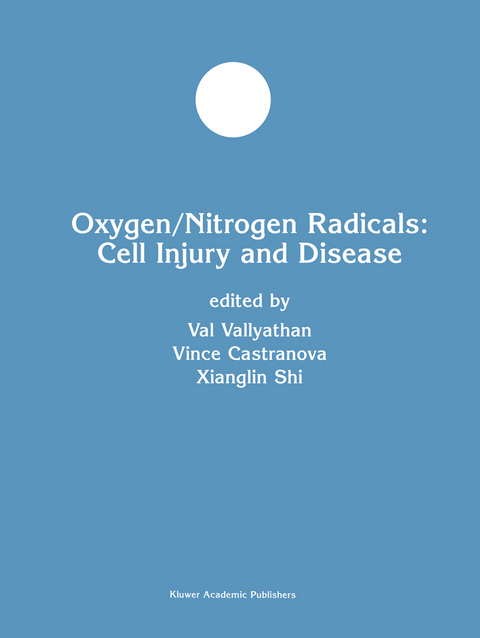
Oxygen/Nitrogen Radicals: Cell Injury and Disease
Springer-Verlag New York Inc.
978-1-4020-7085-3 (ISBN)
A veritable mountain of literature has been published showing the causal relationship of reactive oxygen/nitrogen species in human disease conditions, and there has been an explosion in the understanding of oxidative stress, the protective role of antioxidants and molecular events involved in the regulation of transcription, editing, and translation of key events leading to disease processes. Strategies need to be developed for prevention of diseases by allowing scientists and clinicians to obtain information on new and emerging advances. The molecular mechanisms involved in several diseases including Alzheimer's disease, atherosclerosis, diabetes, arthritis, and Parkinson's disease, as well as disorders of the eye, skin, cardiac, and pulmonary systems are discussed in this volume, along with scientific evidence supporting the value of dietary supplementation with antioxidants in the prevention of cellular damage leading to chronic disease. Special in vivo techniques are also discussed at length, along with the role of molecular studies in human risk assessment.
Cyclic oxidation and reduction of protein methionine residues is an important antioxidant mechanism.- Signal transduction by nitric oxide in cellular stress responses.- Effects of antioxidants against atherosclerosis.- Molecular pathology of dityrosine cross-links in proteins: Structural and functional analysis of four proteins.- The role of nitric oxide in lung innate immunity: Modulation by surfactant protein-A.- Redox signaling.- Control of mitochondrial membrane potential and ROS formation by reversible phosphorylation of cytochrome c oxidase.- Molecular mechanisms of nitrogen dioxide induced epithelial injury in the lung.- Differential role of hydrogen peroxide in UV-induced signal transduction.- Upregulation of phosphoinositide 3-kinase and protein kinase B in alveolar macrophages following ozone inhalation. Role of NF-KB and STAT-1 in ozone-induced nitric oxide production and toxicity.- Phospholipase D/phosphatidic acid signal transduction: Role and physiological significance in lung.- Role of mitogen-activated protein kinases (MAPK) in cell injury and proliferation by environmental particulates.- Doxorubicin-induced apoptosis: Implications in cardiotoxicity.- Depletion of Bcl-2 by an antisense oligonucleotide induces apoptosis accompanied by oxidation and externalization of phosphatidylserine in NCI-H226 lung carcinoma cells.- Interactions of copper with glycated proteins: Possible involvement in the etiology of diabetic neuropathy.- Mechanisms of neutrophil-induced DNA damage in respiratory tract epithelial cells.- Asbestos-induced alveolar epithelial cell apoptosis: Role of mitochondrial dysfunction caused by iron-derived free radicals.- Involvement of hydrogen peroxide in asbestos-induced NFAT activation.- NF-KB, a pivotal transcription factor in silica-induced diseases.- Effect of inhaled crystalline silica in a rat model: Time course of pulmonary reactions.- The role of AP-1, NF-KB and ROS/NOS in skin carcinogenesis: The JB6 model is predictive.- Reactive oxygen species in choline deficiency induced carcinogenesis and nitrone inhibition.- Tumor necrosis factor-a gene promoter polymorphism in coal workers’ pneumoconiosis.- Nitric oxide decreases the sensitivity of pulmonary endothelial cells to LPS-induced apoptosis in a zinc-dependent fashion.- Cytokine polymorphisms in silicosis and other pneumoconioses.- Endogenous regulation of the acute inflammatory response.- Role of nitric oxide in liver ischemia and reperfusion injury.- Oxidative stress and TNF-a induce histone acetylation and NF-KB/AP-1 activation in alveolar epithelial cells: Potential mechanism in gene transcription in lung inflammation.- Heme oxygenase/carbon monoxide signaling pathways: Regulation and functional significance.- The role of oxidative stress in nickel and chromate genotoxicity.- Arsenic carcinogenicity: Relevance of c-Src activation.- Roles of ferritin and iron in ischemic preconditioning of the heart.- Molecular mechanisms of Cr(VI)-induced carcinogenesis.- Arsenic induces oxidative DNA damage in mammalian cells.- Generation of reactive oxygen species in the enzymatic reduction of PbCrO4 and related DNA damage.- Soluble metals as well as the insoluble particle fraction are involved in cellular DNA damage induced by particulate matter.- Nitroxides as antioxidants: Tempol protects against E09 cytotoxicity.- Reversal of fluoride induced cell injury through elimination of fluoride and consumption of diet rich in essential nutrients and antioxidants.- Measurements in vivo of parameters pertinent to ROS/RNS using EPR spectroscopy.- In vivo imagingof free radicals: Applications from mouse to man.- In vivo bioassays of acute asbestosis and its correlation with ESR spectroscopy and imaging in redox status.- On the application of 4-hydroxybenzoic acid as a trapping agent to study hydroxyl radical generation during cerebral ischemia and reperfusion.- In vivo detection of nitric oxide distribution in mice.- In vivo measurement of tumor redox environment using EPR spectroscopy.- Index to volume 234/235.- Instructions to Authors.
| Erscheint lt. Verlag | 31.7.2002 |
|---|---|
| Reihe/Serie | Developments in Molecular and Cellular Biochemistry ; 37 |
| Zusatzinfo | VIII, 406 p. |
| Verlagsort | New York, NY |
| Sprache | englisch |
| Maße | 210 x 279 mm |
| Themenwelt | Medizin / Pharmazie ► Medizinische Fachgebiete ► Pharmakologie / Pharmakotherapie |
| Naturwissenschaften ► Biologie ► Biochemie | |
| Naturwissenschaften ► Biologie ► Zellbiologie | |
| ISBN-10 | 1-4020-7085-3 / 1402070853 |
| ISBN-13 | 978-1-4020-7085-3 / 9781402070853 |
| Zustand | Neuware |
| Informationen gemäß Produktsicherheitsverordnung (GPSR) | |
| Haben Sie eine Frage zum Produkt? |
aus dem Bereich


